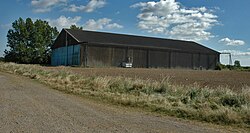| RAF Grimsby RAF Waltham | |||||||||||
|---|---|---|---|---|---|---|---|---|---|---|---|
| Waltham, Lincolnshire in England | |||||||||||
 Surviving B1 hangar | |||||||||||
| Site information | |||||||||||
| Type | Royal Air Force satellite station 1941-43 12 Base substation 1943- | ||||||||||
| Code | GY | ||||||||||
| Owner | Air Ministry | ||||||||||
| Operator | Royal Air Force | ||||||||||
| Controlled by | RAF Bomber Command * No. 1 Group RAF | ||||||||||
| Location | |||||||||||
| Coordinates | 53°30′11″N000°04′56″W / 53.50306°N 0.08222°W | ||||||||||
| Site history | |||||||||||
| Built | 1941 | ||||||||||
| Built by | John Laing & Son Ltd | ||||||||||
| In use | November 1941 - 1946 | ||||||||||
| Battles/wars | European theatre of World War II | ||||||||||
| Airfield information | |||||||||||
| Elevation | 22 metres (72 ft) [1] AMSL | ||||||||||
| |||||||||||
Royal Air Force Grimsby or more simply RAF Grimsby is a former Royal Air Force satellite station located near Grimsby, Lincolnshire, England. The site was operational during the Second World War as part of RAF Bomber Command initially as a satellite station for the Vickers Wellington bombers of RAF Binbrook. By early 1943 the station was equipped with Avro Lancaster bombers of No. 100 Squadron RAF.
Contents
- History
- Inter war years
- Second World War
- Post-Second World War
- Memorials
- Buildings
- RAF Grimsby photographs
- References
- Citations
- Bibliography
- External links
Although the station was officially called RAF Grimsby, servicemen and locals referred to it as Waltham, the name of the nearby village Waltham. [2]






